Day 1: Halle→Munich→Zagreb
To Ex-Yugoslavia! After several trips to some destinations in Asia and the Middle East, it was about time to explore some new places "in the neighbourhood". As a GDR (=East Germany) citizen, it was basically not allowed to visit Yugoslavia. After 1989 it became possible, but since a few crazy Yugoslavians decided to dismantle this fragile, artificial structure called Yugoslavia with a big bang, it wasn't really recommendable to travel around the area unless waving a UN flag.
Aircrafts are a nice invention for sure - however, there's the good old railway, too, creating this certain feeling of really having moved. But we've got two weeks only, and so we decided to go for the so called Kroatien-Ticket, available in Germany and Austria: From Halle in middle Germany to Split in Croatia for around € 250. Return ticket and good for two persons. Unfortunately the route is fixed, but it's possible to jump out and on the train halfway wherever you want. Apart from the first destination, we had no clue at all how to go and where to go.

| ||
| St. Stephen's Cathedral in Zagreb |
It took a while until we left the border post in Jesenice and continued southwards. The area looked a bit like the Elbe Valley near Dresden, but here it's limestone. The villages, the streets, the train stations - everything was like East Germany. A bit dirty here, a bit shabby there, but quite modern. Around 2 p.m. we arrived in Ljubljana, which was going to be our last destination before we return (as written above, the route back had to be the same). We continued all along a small, blue river. Somewhere I spotted a Croatian flag. What!? Are we already in Croatia? Where's the border?
After getting rid of the luggage at the train station, we went out for a walk through the city. The station itself - ugh! The square in front of the station - wow! A pleasant city without any tourists (guess they were all at the coast) and only a few people in the streets. We walked around the entire city centre and used all the time we had before sundown. Back at the train station, some gipsy kids asked for cigarettes. Cigarettes!? No way. Our train was scheduled for 11 p.m. In our compartment, an old Croatian was already sitting and enjoying a smoke. Somehow I tried to explain, that smoking is not permitted in compartments. At least this was the place where we were supposed to sleep. He understood and so we had a smoke and a good laugh together in the aisle, followed by one or two beers. The conductor was quite friendly and joined in as well. All in all a very positive first impression.
Day 2: Zagreb → Split → Brač → Split
The compartment was for six passengers, but we were only three, so it was possible to lay down and grab some sleep. The second night on a train. When I woke up, I could see the Dalmatian coast at sunset - a great view and good start for the tour. The train was on time, and after passing a long tunnel we arrived in Split. Some old ladies approached from all directions and offered private rooms. I had no clue of Croatian, so I tried Russian.
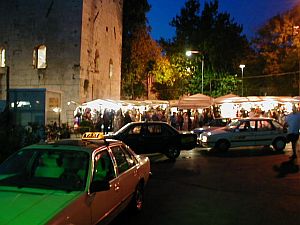
| ||
| Night bazaar next to Diocletian's palace |
After a refreshing shower we left the appartment. To walk around the streets in the heat of the day wasn't promising, and so we went to the ferry terminal to jump on one of the countless islands nearby. First thing we saw was a large seal colony - countless white, mostly fat tourists lining up all along the beach lolling in the sun. Definitely not my cup of tea, but the hinterland of the large island was quite impressive. In the afternoon, we went back to Split on a formerly Japanese ferry. Split is full of tourists, which doesn't come as a surprise. The Diocletian's palace and several more great artifacts explain the popularity of the town. The streets inside the complex palace area are covered with limestone being polished within the centuries and reflecting the sunlight. A walk on the top of the hill in the West offers a great view of old and new Split and the surroundings. Cactusses and the mild climate remind the visitor that this is the mediterranean area. After nightfall we decided for an Italian restaurants. Actually it's easier to find an Osteria or Ristorante rather than Croatian restaurants. The staff was very nice, but somehow senile - it wasn't easy to get what we wanted to get. Nevertheless, all locals we've met so far were very nice and friendly. This even includes staff at restaurants and other places. Which is not a matter of course in East and South East Europe.
Day 3: Split → Dubrovnik
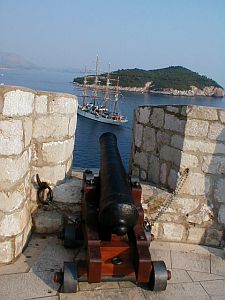
| ||
| Quick! The light for the fuse!!! |
The Dalmatian coast is breathtaking indeed, so it was almost a pity that we already arrived in Dubrovnik after a few hours There, the same procedure as in Split started. Mostly elderly women came from everywhere and grabbed the travellers. A rather elegant looking woman didn't seem to hurry and slowly came to us. At the first view she was a very nice person, and so it wasn't difficult to make a decision. After a few hundred meters walk we arrived at a huge villa surrounded by a shady garden and numerous cats. A great place to stay. There are also chairs and tables in the garden, so it's possible to sit down in the evening and enjoy a chat with other travellers and the family. The family is nice, too, and quite talkative. Besides the 17? 18? cats or so there's even a dog. Must be the quota dog. The poor...
There's not much to say about Dubrovnik. It's a famous town and visitors soon understand why. Especially the complete city wall is very impressive. Yes, it's loaded with tourists, but one cannot expect to be alone in a wonderful place like this in summer. Still it's fun to stroll through the narrow lanes, walk the city wall and all the other sights. A view from the top of the hill is highly recommended. Another attraction is the local cuisine. Fish and sea fruits in countless variations and of high quality. Which was confirmed by all the cats sitting next to our table in an open air restaurant, waiting for the leftovers.
Back in the pension, we admired the photographs hanging on the wall all along the corridor. Burning yachts in the harbour, black smoke rising from the old town and so on. Indeed - this paradise like spot underwent massive shelling a few years ago.
Relevant Links: →Croatia | →Dubrovnik
Day 4: Dubrovnik → Kotor (Montenegro) → Dubrovnik
The day before, we'd noticed that there are busses to Kotor in Montenegro. Together with Serbia, this tiny country forms recent Yugoslavia, sometimes called Rest Yugoslavia (short SCG). Visa regulations after the war became extremely strict, so it was virtually impossible for normal travellers to obtain a visa without much hassle. But what about Montenegro? It's an autonomous republic. Despite the fact that we might have been turned down by border officials, we took the bus to Kotor. The family at the pension frowned at our plan. They hated Montenegro, because Montenegrinians supported the Serbs when they shelled and laid siege to Dubrovnik. The family's son knows what he's talking about - he took part in the war.
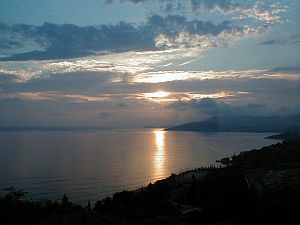
| ||
| Sundown at the Dalmatian coast |
The bay is branched out widely, so the ride didn't see to come to an end. Much later than expected we arrived in Kotor and immediately went to the old city centre. And we were stunned by the atmosphere. Kotor is the small version of Dubrovnik with an Italian touch, very narrwo lanes, a well preserved city wall and no tourists at all. This is what I call I real jewel. At one of the squares we sat down in a restaurant. 8 Deutschmark for a lunch. What, Deutschmark? Since I'm collecting paper money and coins, I was disappointed. I wanted Yugoslavian Dinar, not crumpled DM 5 bills. But I didn't give up and went to the National Bank. But even they had no single bill of Yugoslavian money.
Unfortunately there was no bus back to Dubrovnik. Our luggage was there and we'd already paid the room for the next night, so we had to get back somehow. Thus we took the bus to Igalo, the last town before the border. The driver must have been crazy - he passed every vehicle possible and didn't care at all whether it's in a town or outside. There was a lot of traffic, so we could experience countless risky manoeuvres. Almost all Serbs seemed to have come to Montenegro's coastline for holiday. In Igalo, we soon found out that there's no bus to Croatia. And so we had to hitchhike. After 30 minutes or so, a young Croatian couple stopped and gave as a lift to a small town near Dubrovnik. From there we could catch a bus.
Relevant Links: →Croatia | →Dubrovnik | →Serbia & Montenegro | →Kotor
Day 5: Dubrovnik → Ploče → Metković → Mostar
One or two busses a day go straight to Mostar and Sarajevo, but it's not possible to buy the tickets in advance. First come first served so to say. A lesson we learned that morning. 30 minutes before departure, the bus was already sold out, and so we had to look for alternatives. According to my map, there's a railway track from the border to Mostar. And so we took a bus direction Split and jumped off in Ploče. There we found out, that the next train to Mostar and Sarajevo wouldn't leave before the evening. There was no reason to stay in the middle of nowhere for 8 hrs, and so we took the next train to Metković, a border town. The train must have been from the 1940ies or 50ies - the interior was completely made of wood, and it was even possible to stand outside between the carriages. This is what I call genuine travelling...
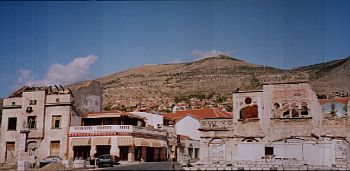
| ||
| The heavily bombed Muslim quarter in Mostar |
A few kilometers before entering Mostar, we saw the first burnt down and looted villages - this gave us some kind of premonition of what we were going to see in Mostar. The student brought us to the city centre of Mostar, where we stepped out the car exhausted and very hungry. Soon we found a nice and modern restaurant. Mostar's not too bad, we thought. Then we walked through the Muslim quarter looking for accomodation. And we were shocked. There's virtually no building not being hit by bullets and mortars. First we wanted to put down our luggage somewhere. After a while we managed to find a pension. The whole family was gathering in the living room watching some funny TV programs. When we entered the room, a hullabaloo started and everyone welcomed us. What a contrast to the ransacked city! After getting rid of the luggage, we took an extensive walk through the entire city centre. Inevitably we ended up at the former frontline. All living houses along the frontline were riddled with bullets, bath tubes, only connected to the wall with the drainpipe, hung in the air. But there were still people living in those houses. A terrible place, and blue sky. A depressing sight, but even worse is the latest trend in Mostar - the contest for the biggest and most magnificent house of God. The slogan seems to be "Look, my church/mosque is bigger then yours, and so is my God!". What a grotesque and dangerous game.
The old city was definitely nice, for sure. We wanted to know more about the older history of the area, and so we headed for the Turkish House. The owner is a very friendly, old man and immediately started to show us the entire building. Coincidentally, a Turkish youth living in Germany was with us, being interested in Turkish history. The old man dressed my companion in traditional harem costume - the result looked pretty nice. Not bad, such a harem. At the end of the wonderful and highly interesting tour we asked for the price. "Just pay as much as you think it's worth to you" Well, after seeing all these ruins in town it was rather priceless.
At night we were strolling around dark lanes to find a good place to eat. A food stall at a vibrant pedestrian zone looked promising. It might be only imagination, but the atmosphere was strange and somehow depressing, with many people looking careworn. While eating, we checked our Japanese guidebook whether there is information on Mostar (a bit late, indeed). And we found something - "It is strongly recommended not to walk around at night" Too late.
Relevant Links: →Bosnia-Hercegovina | →Mostar
Day 6: Mostar → Sarajevo
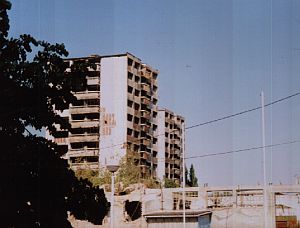
| ||
| There's still much to do in Sarajevo |
Sarajevo is a wonderful, diverse place. Most of the war damages had been removed. Only South of the small river, near the former frontline, some living quarters and industrial areas are still heavily damaged. Modern espresso bars in bullet-riddled dwelling houses give an idea of Sarajevo's return to normality. The dream of a multicultural microcosmos, bursted under shellfire. Still, nowadays are positive impression remains. With the help of many nations, to be seen on trams and busses, construction sites etc., the town had been reconstructed and looks very nice again. If there are any people being sick and tired of war, than it's the citizens of Sarajevo. However, the most famous souvenir from Sarajevo is the so called "Sarajevo Survival Map". Personally I didn't believe in buying such a macabre thing.
Relevant Links: →Bosnia-Hercegovina | →Sarajevo
Day 7: Sarajevo → Tuzla → Osijek
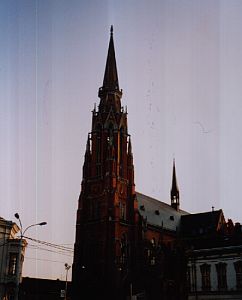
| ||
| The red parish church of Osijek |
We didn't have much time in Tuzla, so we could only walk around a bit in the dreary industrial suburb, but we didn't make it to the centre of town. The next bus went northwards to the border. Before arriving at the border post, we passed large, dusty markets. At the Croatian border, everyone's luggage was examined closely, so it took much more than an hour until we could continue. When we arrived in Osijek, it was already late in the evening. Unfortunately, there're only three hotels in the entire city. One expensive hotel, one costy hotel and one dear hotel. Great. And so we went for the expensive hotel. To be honest, the price was okay - the service was good and it's right next to the central square. Osijek is completely different to places like Zagreb, Split or Dubrovnik. Croatia is not just the magnificent coastline or the beautiful capital - it's also Osijek and other unknown cities. And it's worth a visit as well.
Day 8: Osijek → Vukovar → Pécs (Hungary)
The closest Hungarian city to Osijek is Pécs. According to the map, it's not very far and there would even be a train. Therefore we planned to moved to Pécs first. At the train station, we'd noticed that there is a train indeed, but we'd had many hours left before departure. Thinking about how to kill time, we went to the adjacent bus station. At that time, a bus started the engine, "Vukovar" was written on the windscreen, and so we jumped in. Vukovar is not far, so it shouldn't be a problem to be back in time. Vukovar!? Somehow I've heard this name quite often in the news, in connection with the fierce war. The bus speeded to the East. Before entering Vukovar, we passed huge industrial complexes, all of them heavily damaged. The trip didn't even take one hour. We first went to the Danube riverside. When walking through the streets, we recalled the scenery in Mostar. But Vukovar is even worse - the entire city looks like the former frontline in Mostar. Most buildings are in ruins, chimneys and other high structures were topped and even the formerly beautiful Eltz' Palace was completely wasted. Remains of a full-scale war. Only the Danube flows as ever. On the other side of the river, Serbia is waiting. To "understand" Ex-Yugoslavia, we need to go there as well. But this is going to be another story.

| ||
| Common scenery in Vukovar |
Vukovar is no place to stay for a long time, and so we used the privilege to flee the scene forever on the next bus. Though it would be interesting to visit the place again in a few years. Silently we went back to Osijek, where we still had much time left. And so we took the next train to a small provincial town called Beli Manastir halfway between Osijek and the Hungarian border. A policeman watched us getting off the train and started a small investigation about the reason for our surprising visit to the middle of nowhere. After explaining, that we would leave the city with the next train, the sheriff looked satisfied and got a bit friendlier.
The almost empty train turned out to be an extremely slow one. The Hungarian border guards were quite funny and after joking around asked us, whether we would insist on a stamp in our passports. An unusual question to a German - usually German passports never get stamped in middle Europe. Although only some dozen kilometers away, it took more than two hours to Pécs. Finally we got out of the monotonous plain land. At first, we walked to the tourist information to find reasonable accomodation. At first sight, the city looked very interesting. The staff at the information arranged a nice private room for a reasonable price. They handed out a small map and marked the place, but there were almost no street names on the map and the marked spot proved to be wrong. I seldomly get lost, but when I get lost, I do get lost properly. It took more than an hour of running in circles to find the place. Just to get told, that we were late and so the room had been already given away. But the owner has a friend living in the suburbs, so she gave us another address and sent us there.
I always wanted to sleep in a Hungarian suburb far away from everything. But somehow we managed to find the dreary living quarter and the appartment. The "friend" turned out to be an around 80 years old lady, with the furniture being around the same age. She doesn't know a single word in a foreign language, and so it was quite a challenge. Nevertheless she was talking the hind legs off a donkey. However, she sounded like the 5th element in the movie of the same name, and that was just too interesting. "Vendéglõ!?" (restaurant) I quoted the guidebook, because we were terribly hungry. This causes another torrent of words, but thanks to her we managed to find a nice restaurant nearby. Unfortunately, the centre of town was too far away for going there for a beer. What an exhausting day.
Relevant Links: →Croatia | →Osijek | →Vukovar | →Hungary | →Pécs
Day 9: Pécs → Szeged
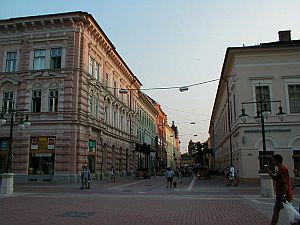
| ||
| The reborn phoenix: Szeged |
We didn't regret our decision. Almost completely wiped off the map by a disastrous flood at the end of the 19th century, Szeged had been rebuilt immediately thanks to international solidarity. Quite common today, such a huge attempt to help another nation to fight the damage done by natural disasters wasn't very common a hundred years ago. The result is an interesting, well balanced potpourri of architectural styles. Only the large Votive church appeared to be rather ugly. We renamed the brown building 'Gingerbread Church'. Again we had bad luck when looking for accomodation. The place we were headed for seemed to have closed. At least the guard turned us away in a rude manner. At the end we managed to find a student's dorm where we could stay for a night. Unfortunately there were almost no students at all, and so we went out alone in the evening. There, I was desperately seeking a place serving 'Szeged style gulyas' - quite famous all over Middle Europe, but obviously not in Szeged itself.
Day 10: Szeged → Budapest
Actually I didn't really have the intention to go to Budapest again. I've been there around 12 years ago and couldn't recall a lot of that visit. But I remember well that it was a time going down in history. The GDR (East Germany) started to dissolve slowly but inevitably before it suddenly imploded. In Hungary, we'd got a sense of foreboding that something would happen. Leaflets containing information on a certain festival taking place in a small town at the Austrian border had been handed out to GDR citizens. The incredible news was that the border was planned to be opened for the day, and so thousands of people fled to West Germany via Austria. Back to Hungary. Having been to Hungary without seeing the capital is not excusable and so I offered my companion to go North to Budapest.
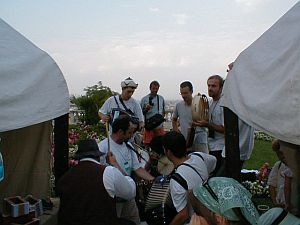
| ||
| Romanian musicians performing on Castle Hill |
An express train took us to the capital. There's plenty of accomodation in Budapest, which is rather confusing. And so we consulted our guidebook and decided on a cheap hostel. At the train station, countless touts were running around trying to offer more or less dubios accomodation. Even in front of the station the struggle went on. However, one tout seemed to be from the hostel we were heading for, and so we got our hands on some vouchers.
There were two deciding factors for the hostel of our choice. A reasonable price and a 24-hours-bar. Since Dubrovnik, we hadn't met other travellers at all, except for one or two pensioner's parties. Our hostel seemed to be popular with backpackers. But the hostel was rather disappointing. Extremely small rooms, wooden double beds, obviously made for children, and noisy. To lazy to look for other options, we stayed there. The weather was nice, and so we went out for an extensive walk through vibrant and beautiful Budapest. The city is definitely too big to get an idea of it all within a couple of days. Where are the most interesting, not tourist loaded quarters? Surely a problem with every big city.
After enjoying a large supper, we sat down in the hostel bar. The bar was packed, and so we could meet travellers from all over the world. Having stayed in very quiet places only before, it was quite a strange atmosphere. Talking to other people, we found out that many travellers took exactly the same trail. Almost no one simply zigzags through the area, staying in places not mentioned in guidebooks etc. What a pity, but this is the way most travellers start, and so did I. Another traveller told us, that Serbia had opened its borders for almost all Westeners for the summer. Unfortunately this information came too late.
Day 11 & 12: Budapest → Esztergom → Szentendre → Budapest

| ||
| The huge cathedral of Esztergom |
The next day we'd planned to explore some smaller cities near the capital. And so we took a slow train to Esztergom in the North. A nice, small town with a huge cathedral. Not just the dimensions of the church itself, but also the crypt inside was very impressive. The other side of the Danube river is already Slovakian territory. A very nice country, too, but at that time my Japanese companion still needed a visa for Slovakia, and so we couldn't go there. We continued on a bus along the so called 'Danube Bend' to another small city named Szentendre. A beautiful small city centre, but way too many tourists in the streets. After two hours (I admit without seeing a single museum) we'd had enough and returned to Budapest, to stay the third and last night in the noisy, narrow hostel. So that was Budapest again. A marvellous city, indeed, but I decided not go there again in the near future. A feeling quite similar to the Prague-Syndrome.
Relevant links: →Hungary | →Esztergom | →Szentendre
Day 13: Budapest → Ljubljana
Slovenia was supposed to be the last place to visit on our tour through the Balkans. Five countries in two weeks - actually we were speeding. Japanese style travelling so to say. But we got the feeling, that we'd used the time intensively. There are two ways of travelling. One is to travel slowly and leisurely, maybe on foot or by bicycle.
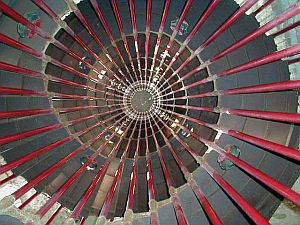
| ||
| The double spiral staircase Ljubljana's castle |
To get to Slovenia, we had to take the express train from Budapest to Ljubljana, capital of Slovenia. To hear the fare was quite a shock - a return ticket for one person is not less than € 45. We didn't plan to return to Budapest, but due to a ridiculous discount system a return ticket is cheaper than a one-way ticket. Maybe we can sell the tickets in Ljubljana, we hoped. The train was very modern, convenient and packed. All carriages were air-conditioned. First we crossed Western Hungary, then we entered Slovenia. There we could finally enjoy some mountains again. After a few hours we passed Maribor, Slovenia's second biggest city. I wondered why this place isn't mentioned in any guidebooks - is it really such a boring place? Somehow I wanted to find out, but we'd already paid the ticket all the way to Ljubljana, and so we didn't get off before arriving the capital. The whole trip took around nine hours - more than expected. Soon we managed to find a reasonably priced hotel. A quick first walk through the city, but it was getting dark soon.
Relevant links: →Slovenia | →Ljubljana
Day 14: Ljubljana → Bled → Ljubljana
As far as we knew, one of the main reasons to visit Slovenia is Bled and the lake with the same name. Bled is located in the Northwest of the small country, near the border to Austria and Italy. The popularity proved to be right - the bus was packed with other travellers. It didn't take much time to get there, and soon the Julian Alps and the almost triangular Mt. Triglav came into view.
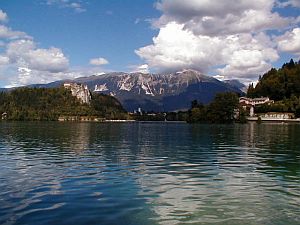
| ||
| Beautiful Lake Bled and the Alps |
At night, we wanted to enjoy some entertainment somewhere in the centre of Ljubljana. Walking along one of the many pedestrian zones, we spotted a bar and could hear punk music from inside. Is this a nice, small club playing good music!? We wanted to find out and entered the place. Inside, some suspicious youths were sitting at the counter. The staff was friendly but strange somehow. We ordered a beer. After a while, I could understand parts of the lyrics. German music, for sure. Then, I'd understood and it was somewhat of a shock - this wasn't punk music, it was Neonazi music at its worst - illegal in Germany. In the middle of lovely Ljubljana we ended up in a fascist club. Slovenian nazis - what an irony! Now we had to keep a clear head. We finished the beer slightly faster then normal, paid the bill and went to the exit as cool as possible. I wouldn't probably get into much trouble since I'd had quite short hair as well, but my companion is Japanese. The suspicious youths at the counter shouted something in Slovenian and threw an empty can. At this instant, I thought about telling those pricks what Hitler thought about Slavs and what he would have done to them. In view of the fact that there were too many of them and since I didn't know whether my health insurance for abroad was still valid, I let go at that. What was left was the realization that there are very sick people everywhere on this planet. And I was filled with remorse for my companion experiencing something like this.
Relevant links: →Slovenia | →Ljubljana | →Bled
Day 15: Ljubljana → Koper → Trieste (Italy) → Ljubljana
Ljubljana is conveniently located in the middle of the country, and so it's possible to do many different day trips from there. We'd chosen Trieste in Italy - not a Slovenian city, but well connected with the history of the area. And if there's a chance of going to Italy, I usually do not let it slip. This was going to be the fifth visit to Italy, but I've never been to famous places such as Roma, Venice, Milan or Naples. Instead of that, I'd only visited less famous places such as Melazzo (Sicily), Bari, Padova and so on. Trieste was to be added soon. To get there, we first took a bus to Koper at the Sea, and from there another one to the centre of Trieste. Now we'd finally left the Balkans and arrived in the typical Italian traffic chaos. It was quite amazing to see the booming hinterland of the big city.
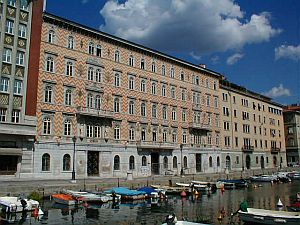
| ||
| At the Canale of Trieste... |
Trieste is an Italian city, and so we were very surprised to see a gorgeous Russian-Orthodox church in the centre. All in all, Trieste offers an interesting mix of medieval structures, typical Hapsburg architecture and a distinctive Venice flair. The pleasure of having a large plate of Parma ham and melon for lunch alone was a good excuse for visiting Trieste. And we didn't even have to pay a table charge - usually a custom in Italy. Trieste is quite big and chaotic. Which is easy to confirm by having a look from the old caste. After several hours of extensive sightseeing, we returned to Ljubljana via Koper.
In the evening, while walking along the small river Ljubljanica, we discovered a small pizzeria, which looked interesting. Having visited Italy in the daytime, we could also finish the day in an Italian way. We gave it a try and went for the medium size pizza. They only had two sizes - medium and big. The moment the waiter came back with the pizza, we were puzzled. Where's the camera? Are we on T.V. now? The pizzas had the size of a regular car tyre - and that's what I call a challenge. (for pizza fans - the name of the restaurant is 'Ljubljanski Dvor'). The diameter must have been 50 cm or so. Even today I wonder how I managed to eat the whole monster. My companion gave up after having eaten half of it. Seeing this, the waiter smiled and said 'Too much, isn't it?' Indeed. Unfortunately we couldn't find out what size the big version would have been.
Relevant links: →Slovenia | →Ljubljana | →Triest
Day 16: Ljubljana → Postojna → Ljubljana → Munich
The last day of our trip already had started. We'd made reservations for the night train to Munich, which would live shortly before midnight. And so we had much time left. Slovenia is also famous for its Karst region, which usually involves a couple of caves. Slovenia's Southwest looks like a Swiss cheese. Especially two caves became famous. The better (i.e. less frequented) one is difficult to reach without own transportation, and so we had to opt for the famous one. The caves at Postojna are very popular with tourists - everyone seems to go there. Hundreds of tourists flocked to the caves. The caves and everything around appeared to be some sort of speleological disneyland. Visitors enter the caves in roller coaster-like tippers. After that, the flocks get guided through some caves. Unfortunately, many stalagtites etc. have been damaged. After one and a half hour everything's over.
After getting back to Ljubljana, we even had time left for another extensive walk through the city. At night we slowly returned to the train station. This was a relaxing end for the tour. A beginner's course on the Balkan's. An area definitely worth a second and third and hundredth visit. The night train was completely booked out. We arrived in Munich early in the morning and had much time to do some sightseeing in Munich - for the first time in my life. Travelling the wildest places without knowing one's own country is strange, indeed...
Relevant links: →Slovenia | →Ljubljana | →Postojna
©2024 Europe-East.com

 Albania
Albania Travelogue Index
Travelogue Index